Positive Health Online
Your Country

Castaways - Complications of No Therapy Following Cast Removal
listed in bodywork, originally published in issue 191 - February 2012
A 28 old athletic trainer came up to me during a seminar I was giving on stretching and scar tissue. He wanted my opinion about a scar on his upper quadriceps which was the end product from an 18 year old surgery. He had Osteomyelitis at 10 years old and was casted up to his ribs after the surgery. Once they removed the cast no rehab was offered or been suggested to his parents. He was told to "go and play now". The scar tissue development alone had caused complications throughout his body, from shortened muscles to misalignments. The needs of children are completely overlooked when it comes to injury rehabilitation and the ability to cope with the physical stress of daily life.
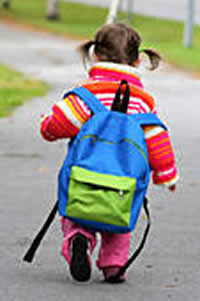
It is frightening how children are often tossed back out into the world after an injury or surgery without any form of therapy based on the belief that ‘they will grow out of it’. I often ask my students "Does anyone work with children?". In a room of 30 or more I may see one hand raise up. Massage and Physical therapy is just not thought of or prescribed for children unless there is a major disease/disorder involved. If you search online for physical or massage therapy for children all that comes up is rehab centres in hospitals for Autism, Cerebral Palsy, and other neurological disorders.
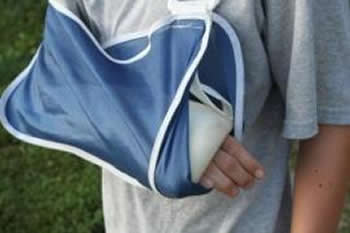
broken arm
A perfect example of the disregard for adolescent therapy is the removal of a cast. About 15% of all injuries in children are fracture injuries.[1] Bone fractures in children are different than adult bone fractures because a child’s bones are still growing. Also, more consideration needs to be taken when a child fractures a bone since it will affect the child in his or her growth.[2]But the consideration is for the application of casting the broken bones. Treatment for the physiological effects of wearing a cast for significant periods of time is not even an afterthought. Once the cast is removed, the medical world sees job as completed.
The bone healing straight is not the goal. The goal is to restore the child's whole body. Putting it back on its pre-destined growth track.

I had a 12 year old male client who was coming in once a week for Stretching and Scar therapy for an injured ankle (up and coming soccer star). During this time he also broke the growth plate in his wrist (approximately 15% to 30% of all childhood fractures are growth plate fractures[3] ). A week after the cast was removed I asked him how his wrist was. He raised his hand and said fine. The fracture was healed, but fine is not a word I would have used. His thumb was adducted toward his palm and the thenar eminence was noticeably atrophied. It only took ten minutes of stretching, massage and some manual resistance and the thumb was back in place.
Even if the Tech removing the cast was not qualified to work on the child, where was the instruction to the parents? The Mother was totally unaware that the child's thumb had been adversely affected by the cast. For that matter, what about the child's arm, shoulder, neck and even hips? A cast, while a tool of healing, can have detrimental lifelong consequences. The added weight, awkwardness, and restrictions of wearing a cast throws the entire body out of balance. The compensation for the imbalance will set up a kinetic chain which will hinder the body's develop throughout life. A long term whole body approach to a child's well being must be addressed once a cast is removed.
It is not only in area of cast removal that proper treatment is deemed unnecessary. I have another client, 14 year old male w/ Pectus carinatum (deformity of the chest characterized by a protrusion of the sternum and ribs) also known as pigeon chest. He stands with the typical posture of many 14-year-old boys, slouched forward, head forward and down. His right shoulder was internally rotated and basically stuck to his chest. The left side was rounded forward in compensation with the right. His arms were rotated outward, giving him the appearance of normal function.
The boy had broken his collarbone coming through the birth canal. He was put in a sling and that was it. Over the years, the Mother had asked the doctors if there was a problem with the way her son's shoulder was developing and the reply was always the same: "No that is just the way he is growing." So with her and her son's permission, I started to work on his shoulder. I gently went through the stretching/strengthening protocols for the shoulder and neck while explaining to him what I was doing and why, making sure that he was actively involved in every aspect of the session. Within 20 minutes, his shoulder was no longer pressed against his chest and was already gravitating to its proper functional position. But he had a long road ahead of him. Fortunately we caught him just before his next growth spurt.
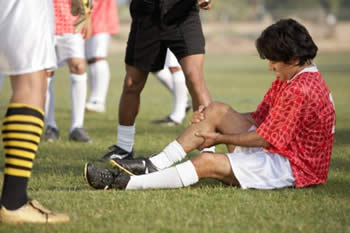
Soccer player holding injured knee
Sports injuries are on the rise in US children and teenagers. Each year more than 3.5 million sports-related injuries requiring medical treatment occur in children under age 15. Today, as more and more children and adolescents participate in the same sport year-round, many young athletes are developing overuse injuries. In fact, overuse is responsible for about half of the sports injuries that happen to middle school and high school students. Overuse injuries usually occur over time with prolonged, repeated motion or impact. They range from chronic muscle strains and tendonitis / tendinitis to stress fractures (tiny cracks in the bone).[4]
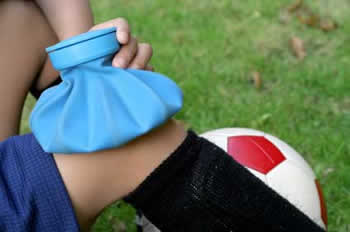
knee injury
Sports-related knee injuries in children and adolescents seem to be increasing at an alarming rate. Researchers at the Children's Hospital of Philadelphia noted a more than 400 percent increase in these injuries at their institution over the last decade, according to new research presented on Oct. 16, 2011 at the American Academy of Pediatrics (AAP) National Conference and Exhibition in Boston. http://en.wikipedia.org/wiki/Child_bone_fracture-cite_note-2 Not only are reconstruction procedures complex, requiring a lengthy recovery, they can potentially impair growth. Many young athletes also return to high-level sports, placing them at high risk of re-injury. According to the presenter, Dr Lawrence, "While we are never going to prevent all injuries, there is good evidence, particularly for some sports like soccer, that sports injury prevention programs can go a long way towards reducing them."
This is what the Father of a client had to say. "My son was born with a unilateral clubfoot. By the time he was 6 he had had three operations to correct it. No rehab was prescribed after any of the surgeries. When he was 9 he was having problems running and playing soccer and lacrosse, the sports he loved playing. The surgeon said it was time for another operation. Before agreeing to that I brought him to see Marjorie. Within minutes she told us that much of the problem was due to the build-up of scar tissue from the previous operations. The adhesions were preventing his foot from straightening out and was contributing to the shortening of the muscles from his hip to his leg. Marjorie began working on his foot and leg. We saw improvement within 3 months. By 6 months it was clear he did not another operation. He continued to see Marjorie and within a year he was the leading scorer on his soccer team."
The scar tissue from the three surgeries was holding the child's foot in an inverted position. He walked on the edge of his foot and hiked his hip to move forward. Instead of more surgeries he is now being scouted by colleges for both lacrosse and football. The scary part is that this boy, now 15 years old, is in my office every week not because of the issues stated above but due to the beating his body takes on daily basis from all of the sports activities.
More and more pressure is being put on kids today to earn scholarships or be the next Tiger Woods. They play multiple sports where the coach is more likely to either be a dad or teacher with no education in proper fitness training. Parents are busy driving from one game to the next and not putting any thought towards the damage being done to the child. After all why should they? Kids are resilient, right? They just do not recognize that adolescents are just as susceptible to overuse and traumatic joint/extremity injuries as adults.
"More adolescents are participating in year-round sports without seasonal breaks, or they are playing on multiple teams simultaneously," according to Thomas M DeBerardino MD an orthopaedic surgeon specializing in sports medicine for the University of Connecticut Huskies and Associate Professor of Orthopedics at the University of Connecticut Health Center ."Adolescent sport-related injuries are on the rise, so much so that they have become a ‘silent epidemic’.[5]
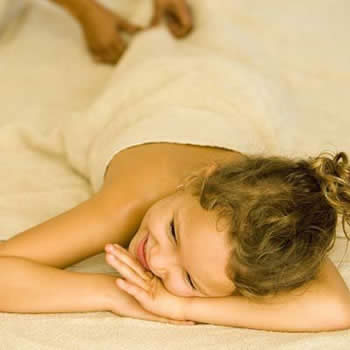
early treatment of children can make a difference
Two separate studies that focus on the dramatic rise of paediatric sports injuries conclude that despite this alarming trend, awareness, education, warning signs and early treatment can make a significant difference.
The effects of sports are not the only issue that is endangering children physically. The Consumer Product Safety Commission (CPSC) estimates that 7,277 emergency visits each year result from injuries related to backpacks. The CPSC also reports backpack-related injuries are up 330 percent since 1996. School children carrying heavy bags is a common phenomenon (Sander 1979; HKSCHD 1988; Negrini and Carabalona 2002). The overloading of schoolbags has roused increasing concern in communities in many countries. Reports from European and Asian countries found that most students carry weights that are more than 10% of their body mass, with many school bags being greater than 20% (Sander 1979; HKSCHD 1988; Negrini and Carabalona 2002).
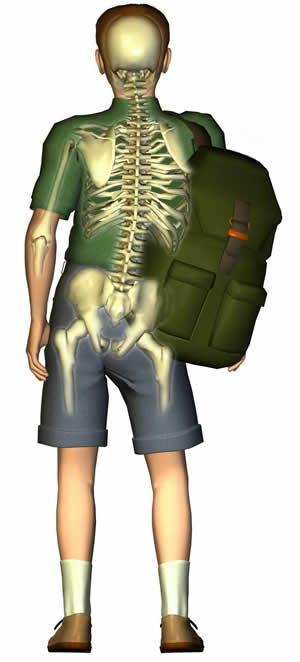
backpack on shoulder
Injury can occur when a child tries to overcompensate for the extra weight by leaning forward, arching his or her back or leaning to the side. Carrying a backpack with one or two straps promoted significant forward lean of head and trunk compared athletic bags or strapless bags. This type of compensation leads to improper spine alignment causing fatigue and strain that may result in further injury. (Wilmarth, 2005) The daily physical stresses associated with carrying backpacks on one shoulder significantly alter the posture and gait of youth. (Pascoe 1997) The forward hunched posture has significant effects on the a child's respiratory and circulation systems as well.
As an Infant Massage instructor I would continually be asked "What would a baby need a massage for?" my reply was always the same "The first year of life is the most stressful one we ever experience." The current attitude towards therapy for children is the same "Kids don't have stress", "It's just growing pains" or "they will grow out of it". I could list half a dozen clients, as I am sure you can, who have issues into their 50s and 60s that stem from surgeries or accidents as children. Many of which have lead to more surgeries, structural injuries and deformities.
A major shift in society's views towards child care needs to occur. It is no longer enough to tell a child to stand up straight and drink your milk. We need to give them the tools, massage, stretching, proper age related strength training in order to avoid the compensation issues created in their daily lives. It is time to stop neglecting the future generations.
References
1. Staheli, Lynn, Fundamentals of Pediatric Orthopedics p. 119.
2. Broken Bones in Children Information about fractures in young patients By Jonathan Cluett, MD. www.About.com Updated: August 29, 2005 Retrieved Sep. 2008. http://orthopedics.about.com/od/fracturesinchildren/Information_About_Fractures_In_Children.htm
4. Sports Injuries A Growing Problem in Kids. USA Today. 2002.
5. Dramatic rise in sports injuries among children called the silent epidemic - Newark Healthy Trends. www.examiner.com/healthy-trends-in-newark/dramatic-rise-sports-injuries-among-children-called-the-silent-epidemic#ixzz1c7BZaP49
Comments:
-
Brian Sutcliffe R.M.T./ L.M.T. said..
I have a question not a comment. I have a client that has pigeon chest on his right side only. He reports that he had a substantial growth spurt, in his teens. He was sedentary as well playing Video games slouch posture. Can you give me some techniques to help mobilize the right side or MFR techniques I might try.
Thank you for your time reading this.
Brian Sutcliffe R.M.T. / L.M.T.